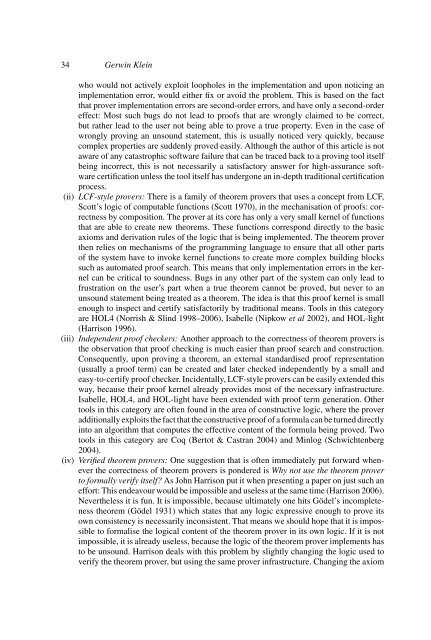Operating system verificationâAn overview
Operating system verificationâAn overview
Operating system verificationâAn overview
Create successful ePaper yourself
Turn your PDF publications into a flip-book with our unique Google optimized e-Paper software.
34 Gerwin Klein<br />
who would not actively exploit loopholes in the implementation and upon noticing an<br />
implementation error, would either fix or avoid the problem. This is based on the fact<br />
that prover implementation errors are second-order errors, and have only a second-order<br />
effect: Most such bugs do not lead to proofs that are wrongly claimed to be correct,<br />
but rather lead to the user not being able to prove a true property. Even in the case of<br />
wrongly proving an unsound statement, this is usually noticed very quickly, because<br />
complex properties are suddenly proved easily. Although the author of this article is not<br />
aware of any catastrophic software failure that can be traced back to a proving tool itself<br />
being incorrect, this is not necessarily a satisfactory answer for high-assurance software<br />
certification unless the tool itself has undergone an in-depth traditional certification<br />
process.<br />
(ii) LCF-style provers: There is a family of theorem provers that uses a concept from LCF,<br />
Scott’s logic of computable functions (Scott 1970), in the mechanisation of proofs: correctness<br />
by composition. The prover at its core has only a very small kernel of functions<br />
that are able to create new theorems. These functions correspond directly to the basic<br />
axioms and derivation rules of the logic that is being implemented. The theorem prover<br />
then relies on mechanisms of the programming language to ensure that all other parts<br />
of the <strong>system</strong> have to invoke kernel functions to create more complex building blocks<br />
such as automated proof search. This means that only implementation errors in the kernel<br />
can be critical to soundness. Bugs in any other part of the <strong>system</strong> can only lead to<br />
frustration on the user’s part when a true theorem cannot be proved, but never to an<br />
unsound statement being treated as a theorem. The idea is that this proof kernel is small<br />
enough to inspect and certify satisfactorily by traditional means. Tools in this category<br />
are HOL4 (Norrish & Slind 1998–2006), Isabelle (Nipkow et al 2002), and HOL-light<br />
(Harrison 1996).<br />
(iii) Independent proof checkers: Another approach to the correctness of theorem provers is<br />
the observation that proof checking is much easier than proof search and construction.<br />
Consequently, upon proving a theorem, an external standardised proof representation<br />
(usually a proof term) can be created and later checked independently by a small and<br />
easy-to-certify proof checker. Incidentally, LCF-style provers can be easily extended this<br />
way, because their proof kernel already provides most of the necessary infrastructure.<br />
Isabelle, HOL4, and HOL-light have been extended with proof term generation. Other<br />
tools in this category are often found in the area of constructive logic, where the prover<br />
additionally exploits the fact that the constructive proof of a formula can be turned directly<br />
into an algorithm that computes the effective content of the formula being proved. Two<br />
tools in this category are Coq (Bertot & Castran 2004) and Minlog (Schwichtenberg<br />
2004).<br />
(iv) Verified theorem provers: One suggestion that is often immediately put forward whenever<br />
the correctness of theorem provers is pondered is Why not use the theorem prover<br />
to formally verify itself? As John Harrison put it when presenting a paper on just such an<br />
effort: This endeavour would be impossible and useless at the same time (Harrison 2006).<br />
Nevertheless it is fun. It is impossible, because ultimately one hits Gödel’s incompleteness<br />
theorem (Gödel 1931) which states that any logic expressive enough to prove its<br />
own consistency is necessarily inconsistent. That means we should hope that it is impossible<br />
to formalise the logical content of the theorem prover in its own logic. If it is not<br />
impossible, it is already useless, because the logic of the theorem prover implements has<br />
to be unsound. Harrison deals with this problem by slightly changing the logic used to<br />
verify the theorem prover, but using the same prover infrastructure. Changing the axiom
















